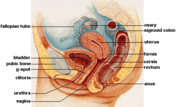Assessment |
Biopsychology |
Comparative |
Cognitive |
Developmental |
Language |
Individual differences |
Personality |
Philosophy |
Social |
Methods |
Statistics |
Clinical |
Educational |
Industrial |
Professional items |
World psychology |
Biological: Behavioural genetics · Evolutionary psychology · Neuroanatomy · Neurochemistry · Neuroendocrinology · Neuroscience · Psychoneuroimmunology · Physiological Psychology · Psychopharmacology (Index, Outline)
| Skene's gland | ||
|---|---|---|
| Skene's Gland | ||
| Latin | ' | |
| Gray's | subject #252 1213 | |
| System | ||
| MeSH | [1] | |
| Human female internal reproductive anatomy. (Skene's gland not labeled, but region is visible.) | ||
In human anatomy (female), the Skene's glands (also known as the lesser vestibular, periurethral glands, paraurethral glands,[1] or female prostate) are glands located on the forward wall of the vagina, around the lower end of the urethra. They drain into the urethra and near the urethral opening. These glands are surrounded with tissue, which includes the part of the clitoris that reaches up inside the vagina and swells with blood during sexual arousal.
Relation with orgasm[]
There is some evidence that nerves in this area produce an orgasm different from the one produced by clitoral stimulation.[How to reference and link to summary or text]
Homology and possible functions[]
The location of the Skene's gland is the general area of the urethral sponge. The Skene's glands are homologous with the prostate gland in males.[2]
Female ejaculation[]
- Main article: Female ejaculation
Some believe that the Skene's glands are the source of female ejaculation.[3] In 2002, Emanuele Jannini of L'Aquila University in Italy showed that there may be an explanation both for the phenomenon and for the frequent denials of its existence. Skene's glands have highly variable anatomy, and in some extreme cases they appear to be missing entirely. If Skene's glands are the cause of female ejaculation and G-spot-orgasms, this may explain the observed absence of these phenomena in many women.[4][5]
| Sex organs
|
| Female genitalia |
|
| Male genitalia |
| see also |
|
Female prostate[]
The fluid that emerges during female ejaculation has a composition similar to the fluid generated in males by the prostate gland,[6] containing biochemical markers of sexual function like Human Protein 1[7] and the enzyme PDE5. When examined with electron microscopy, both glands show similar secretory structures,[8] and both act similarly in terms of prostate-specific antigen and prostate-specific acid phosphatase studies.[9][10][11][12] Because they are increasingly perceived as merely different versions of the same gland, some researchers are moving away from the name Skene's gland and referring to it instead as the female prostate.[13]
Eponym[]
The glands were named after the physician who described them first in Western medical literature, Alexander Skene.[14]
Criticism[]
Many scientists believe that the Skene's gland does not exist at all and that females actually squirt from the urethra. Other scientists believe that only a few women have the Skene's gland and thus capable of squirting. [How to reference and link to summary or text]
See also[]
- Vaginal orgasm
- Pudendal nerve
- Bartholin's gland
- Wolffian duct
- List of homologues of the human reproductive system
References[]
- ↑ Dorlands/Elsevier g_06/12391811
- ↑ Zaviacic M, Jakubovská V, Belosovic M, Breza J (2000). Ultrastructure of the normal adult human female prostate gland (Skene's gland).. Anat Embryol (Berl) 201 (1): 51-61. PMID 10603093.
- ↑ Rabinerson, D, E Horowitz. (February 2007). G-spot and female ejaculation: fiction or reality?. Harefuah. 146 (2): 145-7, 163.
- ↑ Jannini E, Simonelli C, Lenzi A (2002). Sexological approach to ejaculatory dysfunction.. Int J Androl 25 (6): 317-23. PMID 12406363.
- ↑ Jannini E, Simonelli C, Lenzi A (2002). Disorders of ejaculation.. J Endocrinol Invest 25 (11): 1006-19. PMID 12553564.
- ↑ Kratochvíl S (1994). Orgasmic expulsions in women. Cesk Psychiatr 90 (2): 71-7. PMID 8004685.
- ↑ Zaviacic, M, L Danihel, M Ruzicková, J Blazeková, Y Itoh, R Okutani, T Kawai. (March 1997). Immunohistochemical localization of human protein 1 in the female prostate (Skene's gland) and the male prostate.. Histochem J. 29 (3): 219-27.
- ↑ Zaviacic, Z, V Jakubovská, M Belosovic, J Breza. (January 2000). Ultrastructure of the normal adult human female prostate gland (Skene's gland).. Anat Embryol (Berl). 201 (1): 51-61.
- ↑ Zaviacic, Z, M Ruzicková, J Jakubovský, L Danihel, P Babál, J Blazeková. (November 1994). The significance of prostate markers in the orthology of the female prostate. Bratisl Lek Listy. 95 (11): 491-7.
- ↑ Wernert, N, M Albrech, I Sesterhenn, R Goebbels, H Bonkhoff, G Seitz, R Inniger, K Remberger. (1992). The 'female prostate': location, morphology, immunohistochemical characteristics and significance.. Eur Urol. 22 (1): 64-9.
- ↑ Tepper, SL, J Jagirdar, D Heath, SA Geller. (May 1984). Homology between the female paraurethral (Skene's) glands and the prostate. Immunohistochemical demonstration.. Arch Pathol Lab Med. 108 (5): 423-5.
- ↑ Pollen, JJ, A. Dreilinger (March 1984). Immunohistochemical identification of prostatic acid phosphatase and prostate specific antigen in female periurethral glands.. Urology. 23 (3): 303-4.
- ↑ Zaviacic, Z, RJ Ablin. (January 2000). The female prostate and prostate-specific antigen. Immunohistochemical localization, implications of this prostate marker in women and reasons for using the term "prostate" in the human female.. Histol Histopathol. 15 (1): 131-42.
- ↑ Who Named It synd/2038
External links[]
- The paraurethral glands in scientific literature
- New Scientist story
- Sexuality.org G-spot information page
- Orgasm and Sex
| This page uses Creative Commons Licensed content from Wikipedia (view authors). |

